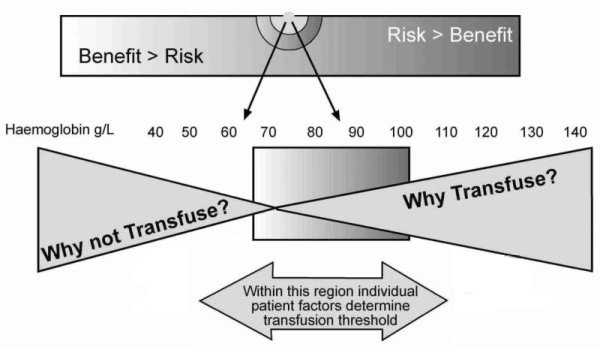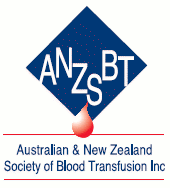The Australian National Blood Authority has produced guidelines for specific clinical situations (e.g. critical bleeding) to assist in deciding when your patient needs blood. The development of these has been assisted by Australian and New Zealand members of the ANZSBT and endorsed by NZBS. ANZSBT and have been adopted by NZBS and Canterbury DHB. The AABB (formerly American Association of Blood Banks) has a similar guideline.
Appropriate Use of Red Blood Cells
The patient's haemoglobin level, although important, should not be
the sole deciding factor in deciding whether to transfuse red blood cells.
Patient factors, signs and symptoms of hypoxia, ongoing blood loss, the risk to the patient of anaemia
and the risk associated with transfusion should be considered.
|
Hb* |
Considerations |
|
< 70g/L |
Lower thresholds may be acceptable in patients without symptoms and / or where specific therapy is available. |
|
70 - 100g/L |
Likely to be appropriate during surgery associated with major blood loss or if there are signs or symptoms of impaired oxygen transport. |
|
> 80g/L |
May be appropriate to control anaemia-related symptoms in a patient on a chronic transfusion regimen or during marrow suppressive therapy. |
|
> 100g/L |
Unlikely to be appropriate |
* The use of red blood cells for indications not listed in this table is unlikely to be considered appropriate as prophylaxis or therapy. Consult the NHMRC / ANZSBT / NZBS guidelines for further details. Clinical and Laboratory indications should be documented.
Specific factors to consider
- Patients cardiopulmonary reserve - if pulmonary function is not normal, it may be necessary to consider transfusing at a higher threshold.
- Volume of blood loss - clinical assessment should attempt to quantify the volume of blood loss before, during and after surgery, to ensure maintenance of normal blood volume.
- Oxygen consumption - this may be affected by a number of factors including fever, shivering and anaesthesia; if increased then the patient's need for red blood cell transfusion could be higher.
- Atherosclerotic disease - critical arterial stenosis to major organs, particularly the heart, may modify indications for the use of red blood cells.
- Speed of onset of the anaemia - slow onset anaemia, e.g. iron deficiency, may not need transfusion. Correction of the cause of the anaemia may be sufficient.
- A transfusion of 4-5mL/kg (1 unit in a 60kg patient) will increase circulating Hb by about 10g/L



